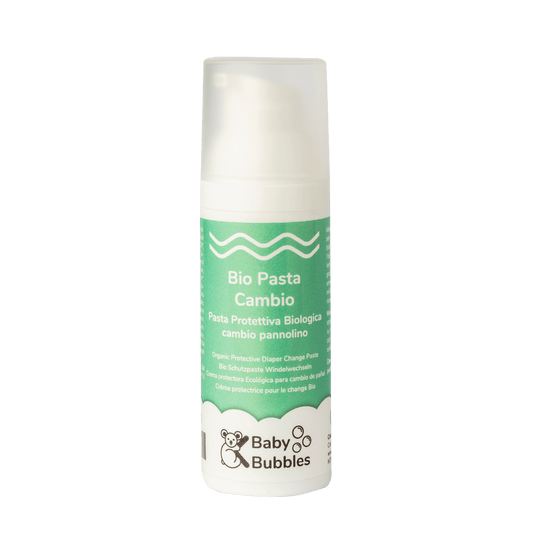Introducing solid foods to your baby is a very important milestone in their development. You’re likely to be full of questions: how do I know when it’s time to start introducing foods other than milk? Which foods? Traditional weaning or baby-led? That's why we’re here today, to guide you through this very important journey.
A guide to weaning
More than weaning, we should really be talking about complementary feeding, as the transition from milk to solid foods doesn’t occur over night. New foods are gradually introduced to a baby while breastfeeding continues to be the main source of nutrition.
Babies need to be able to become familiar with new flavours and progress slowly with new textures, taking time to discover and to understand how to chew and swallow properly.
Some mums choose the baby-led approach, others make their own baby food and others start with ready-made baby food. Always seek advice from your doctor (or health advisor) on how to ensure your baby has a well-balanced diet (carbohydrates, proteins, fats, vitamins, and minerals).
Whatever your choice, it is important not to be too rigid and to follow your infant’s lead: trust your baby, they are able to regulate themselves surprisingly well, they know when it’s time to eat and when they are full.
Let’s start with the practical questions: how old should my baby be when I start introducing solids? Which weaning method should I follow and how should I cut up food to reduce the risk of choking? Read on.
How to know when it’s time to start introducing solids
The WHO recommends exclusive breastfeeding until a baby is 6 months old.
The European Society for Paediatric Gastroenterology, Hepatology and Nutrition (ESPHGAN) and the European Food Safety Agency (EFSA) have the same guidelines, but also consider the possibility of a slightly wider window of four to six months old.
Weaning shouldn’t be started either too early or too late. Introducing solids too soon would lead to sleep disturbances as well as a risk of choking, and too late would impact on a baby’s development.
The ideal time is around six months old, when a baby usually starts to show signs of being ready.
Which signs mean it’s time to start weaning?
- A baby is able to sit up unaided
- He/she starts to show an interest in food while mummy and daddy are eating
- He/she can hold and grasp objects in their hands
- He/she has doubled in weight since birth.
Traditional weaning or Baby-led?
By now everyone has heard of baby-led weaning, which has firmly established itself alongside traditional weaning. Up until a few years ago, the traditional method was the only method used.
What is the difference between traditional weaning and baby-led? Which is recommended?
We are not here to tell you which method is best, but to provide you with the know-how so you can choose the method which is best suited to your baby and family.
Traditional weaning
Traditional weaning involves the gradual introduction of solid foods following a set timeline.
When your baby is six months old you can start to introduce puréed fruit and vegetables into their diet as a snack. Next, we start introducing "meals": beginning with a single meal more of a liquid consistency, puréed or blended vegetables. Then you can start gradually introducing full-fat pasteurised dairy products, such as natural unsweetened yogurt and pasteurised cheese as your child approaches 7 months old.
From 12 months, your baby will be eating 3 meals a day containing a variety of different foods, including: starchy foods, fruit and vegetables, dairy and protein.
During the first two months of weaning, your baby usually has food at lunch or dinnertime, while the other meals are still milk-based. From 7 to 9 months, the number of meals gradually increases to twice a day.
Can a baby try their parents’ food?
Yes, but only once they are eight months old.
What about feeding them when away from home? All you need are bibs, food containers and a thermal bag. Once you’re organised, you won’t find it a problem.
Here are some ideas of first foods you can introduce with traditional weaning.
Which fruit can I give my baby?
If your baby is showing signs of being ready for weaning and you have spoken with your Doctor or Health Advisor, fruit can be introduced from 4 months old, starting with cooked puréed apples and pears and puréed bananas.
Apricots and peaches can also be introduced at a later stage, while nuts and berry fruits, such as grapes, are best left until your little one is 12 months old.
Vegetables
Potatoes, carrots, courgettes, and pumpkin can be introduced from 6 months, and then you can gradually include other vegetables that aren’t sweet, such as, celery, leek, onion, lettuce, cauliflower, fennel, and spinach.
Tomatoes, on the other hand, without their skin, have to wait until your infant is 10 months and aubergines and artichokes 12 months.
Meat
Pork should be introduced from 12 months, cooked ham (free from polyphosphates) after 8 months.
Turkey, chicken, veal, and beef can be given in a puréed form from 6 months, and boiled or steamed from 9 months.
Fish
Generally speaking, the traditional weaning method advises not giving fish until your child is 8 months old, and waiting until 9 months until offering swordfish and salmon.
Can you include yoghurt when weaning?
It is advisable to introduce full-fat unsweetened yoghurt in your baby’s diet from the age of 7 months, when milk-based meals are reduced to two and the other two meals are based around first foods.
How does baby-led weaning work?
Unlike traditional weaning, which involves introducing different foods a little at a time, there are no set rules to follow with baby-led weaning.
A baby sits at the table with his or her parents and actively participates in their meal, tasting what you are eating.
However, you must ensure that any food offered to your infant is healthy. This means if you choose to opt for baby-led weaning, then you will have to follow a healthy, balanced diet which is fat-free and completely salt-free.
Always seek the advice of your doctor or health advisor, who will provide guidance on the correct proportion of milk to solid foods.
How to introduce first foods to your baby with baby-led weaning
With baby-led weaning, you do not need puréed or mashed food, you can offer finger food (food that's cut up into small pieces - NHS weaning advice).
If a baby is truly ready for weaning, then they will soon learn how to swallow. Blending food into a liquid form for your baby is of no use if you opt for baby-led weaning. Just continue with milk until they show signs of being ready and try again.
Finger foods should be chopped and cut in such a way to avoid the risk of choking. Do not force your baby to eat. Wait until next time if they're not interested.
Go at your baby's pace and let them show you when they're hungry or full. Stop when your baby shows signs they've had enough. Help by making them understand how to chew certain foods. Offer encouragement and your attention. Meals may take much longer than usual, but they will lay the foundation for pleasant family time at the table.
Foods to avoid
With baby-led weaning, babies can eat what adults eat, however, there are some exceptions which may prove harmful to their health:
- Foods that contain sugar are bad for your child’s health. At the top of the list are sweets, which can cause choking.
- Foods rich in salt: it is better to reduce the amount to an absolute minimum or, better still, leave it out completely.
- Honey, under 12 months of age, can cause infant botulism. Honey should be avoided completely.
- Mushrooms should only be eaten in small quantities by children up to the age of 12 years old. They are very difficult to digest.
- Seafood can easily be contaminated with bacteria and germs and cause infections such as salmonella and hepatitis A. Such infections can result more serious for a young child than for an adult.
- Cow's milk is not recommended until a baby reaches 12 months old as it contains too much protein and mineral salts.
Guidelines for cutting food safely
Annabel Karmel, frequently referred to as the UK’s number one expert in weaning, has dedicated her latest book Weaning Made Simple to guiding mums through their weaning journey, offering useful guidance on how to prepare, and cut foods.
The NHS – UK Public Health – also have guidelines on how to prepare and cut up your baby’s food when weaning.
Meat and fish should be cut into small pieces, as should cheese, which should be diced. It is important to avoid “the glue effect” which can occur when cooking cheese, as babies aren’t able to cut through cooked cheese with their teeth yet.
Round fruit and vegetables such as grapes, cherry tomatoes, cherries and mozzarella cheese should be quartered into four pieces and any seeds or pips removed.
Fruit and vegetables, which are cylinder-shaped, such as carrots, cucumbers, and bananas, should be cut lengthwise, into narrow batons, and not into round circles. The stringy parts of celery and fennel should be removed.
Dry, hard foods such as biscuits, crackers and nuts should be grounded or crushed into crumbs.
Weaning your baby is an important time. It should be done as calmly as possible to avoid making it a stressful experience for either mum or baby. If you feel your little one isn’t ready, then don’t force them. Trust them, don’t worry that they’re not eating enough, if they’re growing well it means that they are able to self-regulate perfectly.
Don't force your baby to like everything right from the start, you’ll soon see that by waiting and re-introducing a certain food, they’ll soon develop a taste for it. Above all, have fun with your baby! Mealtimes are a time for sharing and smiles.
Source:
Pianetamamma.it
Nostrofiglio.it
Uppa.it
Nhs.uk/conditions/baby/weaning-and-feeding
Nhs.uk/start4life/weaning
Io mi svezzo da solo by Lucio Piermarini
Weaning made simple by Annabel Karmel








